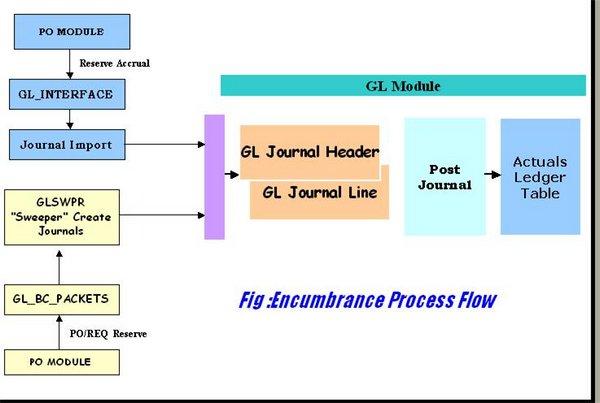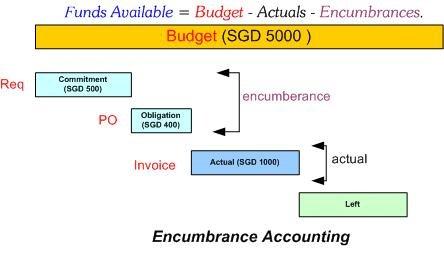Encumbrance Accounting
Encumbrance Accounting
Before start of this topic you should be clear on these term;
- Encumbrance
This is your any pre-expenditure, such as a purchase order, which will lead to a charge against an account. - Commitment
A journal entry you make to record an anticipated expenditure, as indicated by approval of a requisition. - Obligation
An encumbrance you record when you turn a requisition into a purchase order.
So…What Are Commitments?
Commitments are obligations for future expenditures made , and this should be for an employee or vendor PO’s. Commitments are tracked to help departments forecast their expenditures so that they do not exceed their budget available.
If you are using encumbrance you can get answer of these two question.
- How much do I have left to spend?
- Alert me if spending too much from allocated budget.
How much I left to spend , will be based out of these formula
Funds Available = Budget – Actual – Encumbrances.
budget is always unaltered, Encumbrances is reversed when matching to AP invoice.
Oracle Vanilla encumbrance accounting –Briefing
Oracle encumbrance accounting feature is supported by a process called funds reservation, which is implemented in the General Ledger as a user-exit or spawned program.
What is required if enabled Purchase Orders and Purchase Requisitions to first undergo a funds check when they are submitted. The system checks the line amount(s) of the requested purchase against the budget for the GL account(s) and alerts the user if that PO or Req. will exceed the funds on the account.This process of verification of available funds based on pre-defined summary templates.
Journals are then recorded in a special table called GL_BC_PACKETS, where they will sit temporarily before being converted by a concurrent process called “Program – Create journal” into permanent encumbrance journals.
The modules capable of initiating such transactions are the purchasing module for the creation of three documents, Standard Purchase Order, Requisition and Purchase Order Releases and the Accounts Payable module for the different invoices. It is possible to control the type of encumbrance created by these modules via the set-up of the applications.
The benefit of the encumbrance accounting feature is the ability to have the system control the expenditure budget from the General Ledger, reducing the risks of potential over expenditure.
This is often a legislated requirement for public organizations.
The transactional flow has funds reservation being performed through the GL_BC_PACKETS table when reserving funds for purchasing documents, and through the GL_INTERFACE table for receipt accruals which can be either On Receipt or at Period End. The funds checker process takes place whenever funds reservation and/or adjustment is made.
After transactions have taken place in Purchasing, it will become necessary to run the Create Journals program in GL. This program essentially sweeps through the GL_BC_PACKETS table and creates journals for the entries as entered.
Essentially this process allows the different manager to understand their “funds available” based on the following formula.
Funds Available = Budget – Actual – Encumbrance
The Oracle system has the ability to control this formula per fiscal period using the different balances tracked within GL_BALANCES (Essentially the General Ledger) by PTD (Period To Date), QTD (Quarter To Date), YTD (Year To Date),PJTD (Project To Date).
If you are coming from other Products like SAP or SUN , let clear these two terms in Oracle context in Project module specific.
- Actual Transactions – Actual transactions are recorded project costs. Which may includes labor, expense report, usage, burden, and miscellaneous costs.
- Commitment Transactions – Commitment transactions are anticipated project costs. Such examples include purchase requisitions and purchase orders or contract commitments.
Basic Oracle Process
The basic process flow for encumbrance accounting activity related to Oracle Purchasing typically is as follows:
- Create a requisition.
- Approve and reserve funds for the requisition.
- AutoCreate requisition onto a purchase order.
- Approve and reserve PO (which automatically reverses the requisition funds reservation)
- Receive against the purchase order (either period-end or online accruals) and the funds are reversed for the amount received and entered against the charge account.
Take a note, funds reversal also occur when documents are cancelled or finally closed.
Requisitions, when autocreated onto a purchase order, have their funds reversed either when the PO is approved and reserved or when the requisition line(s) are rejected or returned.
Oracle Product associated with encumbrance
- General Ledger
- Purchasing
- Payables
- Projects
- Grants




Helpful blog, bookmarked the website with hopes to read more!